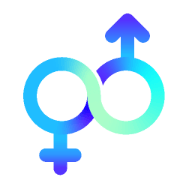Estrogen is commonly associated with females, because it is the primary female sex hormone. Estrogen is a hormone or “chemical messenger” that both men and women have in their bodies.
Estrogen affects almost all cells in the bodies. It is produced in the ovaries (in the female reproductive system), the adrenal glands (two glands above the kidneys) and the fat cells which are found throughout the body.
Read on to find which foods are said to have an impact on your estrogen levels.
Foods high in estrogen
Some of the foods high in estrogen, according to a number of studies include:
- Beans
- Peanuts
- Lentils
- Chickpeas
- Flaxseed
- Soy products
- Dried fruit
- Chocolate
Before we dive deeper, it’s important that we define phytoestrogens and lignans.
Phytoestrogens
Phytoestrogens are naturally-occurring plant compounds that are structurally and/or functionally similar to mammalian estrogens and their active metabolites.
In simpler terms, phytoestrogens have a similar look and feel to estrogens. Phytoestrogens host a number of health benefits. They are associated with lowered heart issues, lower severity of post-menopausal symptoms, a lowered risk of osteoporosis and breast cancer. Phytoestrogens are also considered endocrine disruptors, indicating that they have the potential to cause adverse health effects as well.
Lignans
Lignans are bioactive compounds exhibiting various biological properties, including anti-inflammatory, antioxidant and anti-tumor activities. In simpler terms, lignans are a type of phytoestrogen!
Lignans have an antioxidant effect when bacteria that naturally occur in the body convert lignans to estrogen-like substances.
Read: What does estrogen do? Everything you need to know about estrogen
Beans, peanuts, lentils
Legumes such as beans, lentils and peanuts contain isoflavonoids (biologically active phenolic compounds). These are also sometimes referred to as isoflavones, which are thought to act on the estrogen receptor.
An estrogen receptor is a protein found inside the cells of the female reproductive tissue, some other types of tissue, and some cancer cells. The hormone estrogen will bind to the receptors inside the cells and may cause the cells to grow.
Studies state that there is insufficient data to draw definitive conclusions regarding the use of legumes in hormone replacement therapy for estrogen deficiency.
Chickpeas
Chickpeas contain phytoestrogens. It has been shown that the consumption of chickpeas may lead to a slight increase in estrogen levels.
Chickpeas are also a great source of protein for the non-meat eaters out there.
Read:High estrogen symptoms, causes and treatment
Flaxseed
Flaxseed contain lignans. Flaxseeds are easy to incorporate into the diet. They can be added to breads, salads, cereals and smoothies.
Flaxseed consumption has been shown to improve levels of hormones that are though to prevent certain types of cancers.
Further conclusive research is needed in this area.
Soy products
Soy products contain “plant estrogens” known as isoflavones.
To recap, isoflavones bind to some receptors, they mimic the effects of estrogen.
Some research claims that eating more soy products such as:
- Tofu
- Tempeh
- Soy milk
- Miso
- Edamame
- Other meat alternatives
…can increase the volume of estrogen circulating in the blood.
There is no conclusive evidence on the estrogenic effects of soy products.
Read: Low estrogen symptoms in women
Dried fruit (& fresh)
Fresh and dried fruits and vegetables contain phytoestrogens.
Dried fruits are a particularly good source of phytoestrogens. Prunes, dates and dried apricots have the highest source of phytoestrogens.
Chocolate
Chocolate is a catechin.
Catechins are natural antioxidants that help prevent cell damage. Chocolate is also known as a phytoestrogen.
Are phytoestrogens good for your health?
Phytoestrogens are good for your health.
There is weak evidence to suggest that phytoestrogens are harmful to the body.
Many studies have associated phytoestrogen intake with potential health benefits, including lower cholesterol levels, improved menopause symptoms, and a decreased risk of osteoporosis and breast cancer.
Written by Hannah Kingston on June 21, 2021
References
- The pros and cons of phytoestrogens - ncbi.nlm.nih.gov
- What does estrogen do? Everything you need to know about estrogen - stdwatch.com
- Naturally Lignan-Rich Foods: A Dietary Tool for Health Promotion? - ncbi.nlm.nih.gov
- Estrogen receptor - cancer.gov
- Soy isoflavones: are they useful in menopause?- pubmed.ncbi.nlm.nih.gov
- Flaxseeds and breast cancer - oncologynutrition.org
- High estrogen symptoms, causes and treatment - stdwatch.com
- The Specific Role of Isoflavones on Estrogen Metabolism in Premenopausal Women - ncbi.nlm.nih.gov
- Straight talk about soy - hsph.harvard.edu
- Low estrogen symptoms in women - stdwatch.com
- Effects of soy protein and isoflavones on circulating hormone concentrations in pre- and post-menopausal women: a systematic review and meta-analysis - pubmed.ncbi.nlm.nih.gov
